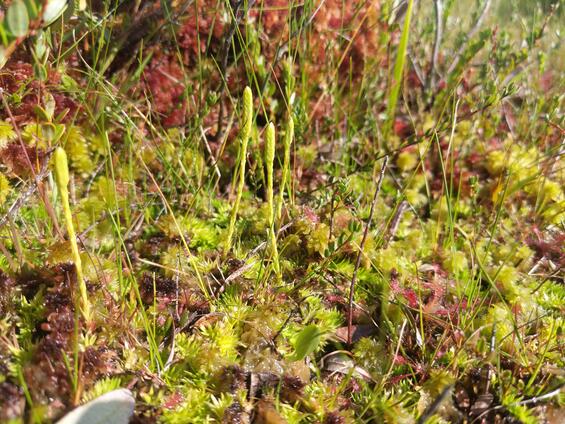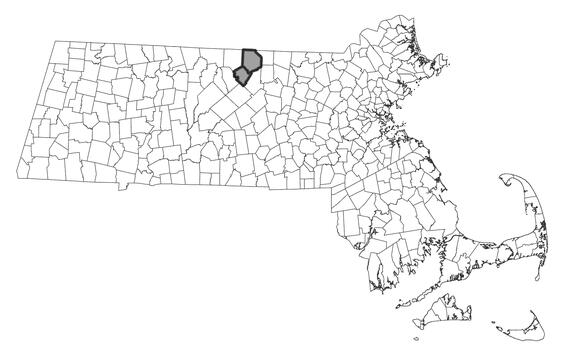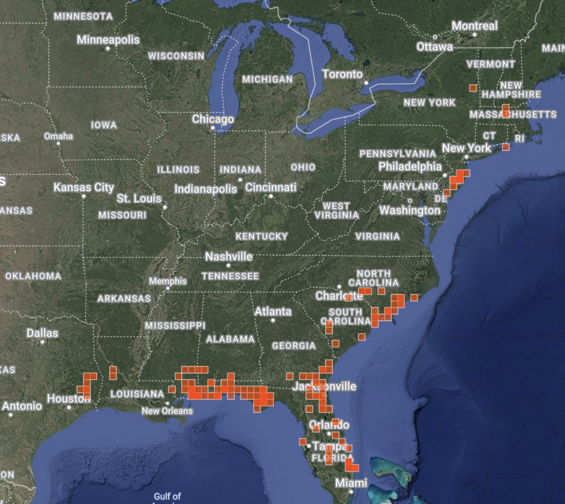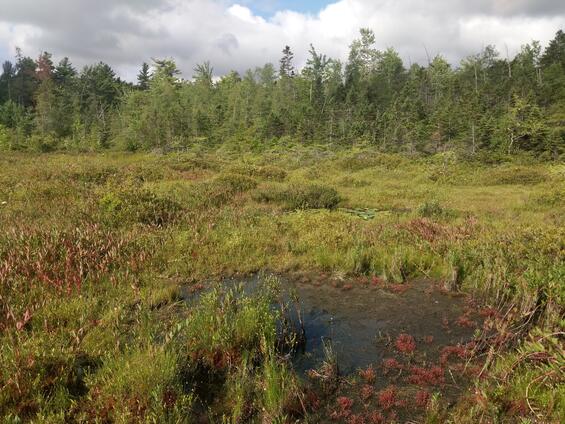- Scientific name: Pseudolycopodiella caroliniana
- Species of Greatest Conservation Need (MA State Wildlife Action Plan)
- Endangered (MA Endangered Species Act)
Description

Slender clubmoss green leaves and last year’s pale reproductive stem on April 17th growing on Sphagnum mosses in a Massachusetts peatland.
Slender clubmoss, Pseudolycopodiella caroliniana, is an evergreen herbaceous perennial member of the clubmoss family (Lycopodiaceae), and the only member of its genus present in the northeast. Slender clubmoss forms colonies from horizontal shoots and produces stem leaves in two ranks, with the outer measuring 3.5-6 mm by 1.2-2 mm (0.14-0.25 in by <0.08 in) and inner measuring 3.5-4 mm by 0.3-0.6 mm (0.15 in by <0.02 in) Slender clubmoss produces spores in a structure called a strobilus (plural strobili) composed of densely arranged leaves, also called “microphylls” in this group of plants. Slender clubmoss produces its strobili individually, on unbranched stalks which reach 5-30 cm (2-12 in) tall. The leaves on the fruiting stalks are appressed, arranged in 4-10 ranks, and shorter than its stem leaves, measuring 2-3 mm by 0.3-0.6 mm (0.1 in by <0.02 in).
Slender clubmoss may be confused with the related northern bog-clubmoss (Lycopodiella inundata) which also produces unbranched fruiting stalks and grows in similar habitats. Northern bog-clubmoss’ leaves are all similar in size which measure (5-6 mm x 0.5-0.7 mm; 0.2 in by 0.03 in) and are arranged in more than two ranks, whereas slender clubmoss has leaves of two sizes arranged in two ranks. Additionally, slender clubmoss is evergreen, and northern bog-clubmoss persists through winter as constricted buds called turions which regrow in spring.

Slender clubmoss growing in a Massachusetts peatland.
Life cycle and behavior
Slender clubmoss produces fruiting stalks in August, with spores ripening and dispersing in September and October. These fruiting stalks turn yellow and may persist with the plants through the spring of the following year. Slender clubmoss is evergreen, so vegetation is present year-round, although it may be under the ice and snow. The color turns pale in the winter.
Population status
Slender clubmoss has recently been elevated from state historic to endangered under the Massachusetts Endangered Species Act (MESA). Historically, slender clubmoss was known from a single site in New England which was believed to have been wiped out in the 1970’s. Currently two populations are known from Worcester County. One of these populations is robust and produces several hundred fruiting stalks each year, while the other encompasses an area of only two square feet. If you see any rare species, please report them through Heritage Hub.
Distribution and abundance
Slender clubmoss is present throughout the Gulf and Atlantic coast states in the United States, from Texas east to Florida and North to upstate New York. It is of conservation concern in several states, including critically imperiled in Massachusetts, New York, Arkansas, and Maryland; vulnerable in Florida and North Carolina; and state-historic in Virginia (NatureServe 2025). An iNaturalist map of 371 research grade observations indicates the plant is uncommon across the range. Since it is evergreen and visible all year around, excepting snow cover in the north, more observations would be expected. Secondly, it shows a consistent pattern of being within 100 miles or so of the coast and generally much closer (iNaturalist 2025).

Distribution in Massachusetts. 1999-2024. Based on records in the Natural Heritage Database.

iNaturalist_research_grade_observations of Pseudolycopodiella_caroliniana [accessed 2025-03-28] showing full extent of U.S. populations.
Habitat
In Massachusetts, slender clubmoss inhabits peatlands such as level bogs and fens. Within these systems, slender clubmoss occurs in areas dominated by herbaceous species, oftentimes on unstable peat mats which are inundated with water at some point in the year. Plant species which co-occur with slender clubmoss include brown-fruited rush (Juncus pelocarpus), bog-bean (Menyanthes trifoliata), horned bladderwort (Utricularia cornuta), pitcher plant (Sarracenia purpurea), large and small cranberry (Vaccinium macrocarpon and V. oxycoccos), and rose pogonia (Pogonia ophioglossoides).
Healthy habitats are vital for supporting native wildlife and plants. Explore habitats and learn about conservation and restoration in Massachusetts.

Slender clubmoss habitat.
Threats
The small population sizes of occurrences of slender clubmoss make it vulnerable to changes in hydrology, excess trampling and over-collecting. Invasive species such as giant reed grass (Phragmites australis) threaten this rare type of wetland. In some cases, nutrient input from roads may impact the wetland causing an increase in cattail or other rushes that may crowd out and shade out low growing plants that need full sun.
Conservation
Survey and monitoring
Given the small population sizes and only 2 populations, much more de novo surveying is needed as well as more thorough resurvey work on known populations. Both populations need increased monitoring. Employing photo monitoring techniques to verify that vegetation cover is not changing in a way that would threaten the plant populations would be valuable in this case. Plant counts might be best done when plants are visible but with frozen or semi-frozen conditions using snowshoes to prevent breaking through or excess trampling of the thin and delicate bog mat. This has already been shown to be a successful approach.
Research needs
Research questions could include reproduction: does this species ever reproduce from spores successfully, and could that be done in a lab environment? Or is vegetative spread more common in intact populations? Can new populations be established through cuttings?
What is the pH of the water where the plant grows? What are the moss species associated with this species? What are the limiting factors for growth where the population occurs?
Acknowledgments
MassWildlife acknowledges the expertise of Matthew Charpentier, who contributed substantially to the development of this fact sheet.
References
Cullina M, Connolly B, Sorrie B, Somers P (2011) The vascular plants of Massachusetts: a county checklist, 1st revision. Massachusetts Natural Heritage & Endangered Species Massachusetts Division of Fisheries and Wildlife, Westborough, MA
Fernald, M. L. 1950. Gray’s Manual of Botany, Eighth (Centennial) Edition—Illustrated. American Book Company, New York.
iNaturalist 2025. Available from https://www.inaturalist.org. Accessed 28 March 2025
NatureServe. 2025. NatureServe Network Biodiversity Location Data accessed through NatureServe Explorer [web application]. NatureServe, Arlington, Virginia. Available https://explorer.natureserve.org/. Accessed: 3/27/2025.
Native Plant Trust website 2025. https://gobotany.nativeplanttrust.org/species/pseudolycopodiella/caroliniana/?key=dichotomous#dkey [Accessed: 3/27/2025].
Contact
| Date published: | May 5, 2025 |
|---|